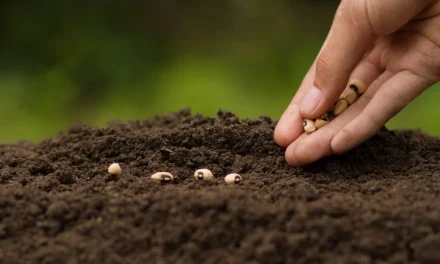Native Business Magazine spoke with John L. Berrey, Chairman of the Quapaw Tribe, about the tribe’s vertical integration model and how the tribe is reclaiming sovereignty of its agriculture and ranching needs. (Courtesy Quapaw Tribe)
Tribes are diversifying and thriving through traditional agriculture economies. In 2018, Native Business Magazine covered important news impacting the agriculture sector, such as the new Farm Bill and the initiation of the Native American Agriculture Fund. We also profiled various tribes growing their agricultural enterprises. Below we spotlight three of our most popular agriculture stories of the year on NativeBusinessMag.com.
The Quapaws in Oklahoma are flourishing by vertically integrating tribal agriculture and food businesses.
The tribe raises hormone-free beef and bison, which is processed at a tribally owned plant on the reservation. The Quapaw Tribe considered opening a processing facility a smart business decision, because it had a built-in market: five tribal restaurants. Beyond that, the tribe’s beef and bison jerky “flies off the shelf” at tribally owned convenience stores, John L. Berrey, Chairman of the Quapaw Tribe, told Native Business Magazine. “It’s got a long shelf life. It’s got about an 80% margin in terms of the economics of the stick.” The USDA-inspected plant also ships meat across state lines for sale in public markets.
The tribe additionally started several greenhouses to grow heirloom vegetables for its restaurants and resorts. Many of the crops that don’t make it to dining tables are used as feed for the tribe’s cattle and bison. “A lot of our commodities—like corn, soybeans and wheat that we grow, we either use them in our feeding facility as part of the rations for our animals, or we sell it on the commodities market. We take that money and roll it into another feed product that would go into our animals. It’s a very vertically integrated process,” Berrey said.
The Quapaws additionally harvest honey from the tribe’s hundred hives. “Our goal is to have a thousand hives,” Berrey said. “We use it in our restaurants for cooking. We sell it retail.”
Berrey added: “We’re constantly looking at what we buy and what we sell and how we can integrate our agricultural businesses to fill product needs and then add value to those products to make more money on those margins.”
Read the full article: Quapaw Tribe: A Model for Success in the Ag World

Angus cattle roam Quapaw lands. (Courtesy Quapaw Tribe)
The Yocha Dehe in California are expanding their olive oil production and distribution.
Blue hills roll along the Yocha Dehe Wintun Nation’s homeland in the Capay Valley of Northern California. Those hills are the namesake of the tribe’s olive oil enterprise: Séka Hills. “Séka” means “blue” in the tribe’s native Patwin language.
The tribe planted its first high-density olive groves in 2008, and in 2011, the Yocha Dehe harvested their first olives. Today the highly acclaimed Séka Hills extra virgin olive oils can be found in over 700 retail stores and restaurants across much of the United States and in Japan.
The tribe debuted its multi-use Tasting Room inside its mill facility in 2015. That was the catalyst for tribal agri-tourism in the Capay Valley. A satellite tasting room at the Old Sugar Mill in Clarksburg opened in June 2017.
“For a small to mid-size specialty foods producer, direct-to-consumer sales are vital,” said Jim Etters, director of land management for the tribe. “Operating the two tasting rooms—one in Brooks and one in Clarksburg—gives us the opportunity to showcase our products and sell our products at a better margin.”
While olive oil anchors the Séka Hills product line, the brand offers an entire line of premium agricultural products produced from the tribe’s homeland. Other tribal products include Séka Hills Wildflower Honey, beef jerky, seasoned nuts, hummus, and pickled asparagus. Séka Hills partnered with Capay Organic to take its organic crops to market.
Read the full article: Yocha Dehe Grows Agri-Tourism and Olive Oil Distribution

The Tamaya Nation of the Santa Ana Pueblo in New Mexico recently secured renowned winery Gruet to purchase the tribe’s grape harvest.
The Tamaya Nation has turned to drought-tolerant plants that thrive in the high desert foothills of the Santa Ana Pueblo, kust north of Albuquerque, New Mexico.
“I wanted to see if we could get a higher return on producing grapes,” Joseph Bronk, Director of Agriculture for the Santa Ana Pueblo, told Native Business Magazine.
With the tribal council’s support, Bronk began work to secure capital through the Administration for Native Americans. But first, he had to find a market for the tribe’s grape harvest.
Bronk approached Gruet, a New Mexico-based winery—and one of the largest producers of Champagne Method sparkling wine in the U.S. The company agreed to purchase the tribe’s annual grape harvest.
“Agriculture is why the Santa Ana people have survived as a community. More than just the management of soils and crops, agriculture is an integral component of Santa Ana lifestyle and religion,” Bronk said. “The cycle of religious ceremonies is a function of the agricultural seasons.”
Read the full article: Santa Ana Diversifies Agricultural Investments With Wine Enterprise

Featured in Print
Agriculture is an ancient indigenous practice. Our native ancestors have long relied on agriculture, as well as commerce and trade, for self-sufficiency and sustainability. For instance, natives in Cahokia cultivated plants for more than a thousand years, embracing the three sisters—indigenous varieties of corn, beans and squash that grew abundantly thanks to the alluvial soil of the Mississippi River Valley. Natives of Cahokia also innovated hunting with the bow and arrow. (Download the November Entrepreneurship issue of Native Business Magazine to read more about Publishers Gary and Carmen Davis’ take on Cahokia as inspiration for modern-day entrepreneurs. The Davises also look to Tenochtitlán, where the Aztecs flourished south of the border in current-day Mexico City, and the Incan city of Machu Picchu, built atop the Andes mountains in Peru, as models of success.)








